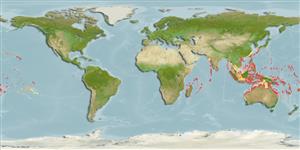Environment: milieu / climate zone / rango de profundidad / distribution range
Ecología
marino asociado a arrecife; rango de profundidad 0 - 36 m (Ref. 1602), usually 1 - 5 m (Ref. 90102). Tropical; 30°N - 32°S, 43°E - 130°W
Indo-Pacific: East Africa to the Hawaiian, Marquesan and Tuamoto islands, north to southern Japan and the Ogasawara Islands, south to New South Wales (Australia) and Lord Howe Island.
Tamaño / Peso / Age
Madurez: Lm ? range ? - ? cm
Max length : 13.0 cm TL macho / no sexado; (Ref. 9710)
Espinas dorsales (total) : 13 - 14; Radios blandos dorsales (total) : 20 - 22; Espinas anales: 3; Radios blandos anales: 16 - 17.
Body shape (shape guide): short and / or deep; Cross section: compressed.
Common in shallow exposed reef flats, lagoons, and seaward reefs; in relatively open areas with scattered corals and occasionally at depth of 36 m (Ref. 205). Benthopelagic (Ref. 58302). May be solitary or in small groups (Ref. 90102). Usually in pairs. Juveniles often in small aggregations and commonly mix with other similar sized juveniles, especially C. kleinii. Feed on small worms, small benthic invertebrates, coral polyps, and filamentous algae. Oviparous. Form pairs during breeding (Ref. 205). Minimum depth reported taken from Ref. 128797.
Life cycle and mating behavior
Madurez | Reproducción | Puesta | Huevos | Fecundidad | Larva
Distinct pairing (Ref. 205). Monogamous mating is observed as both obligate and social (Ref. 52884).
Myers, R.F., 1991. Micronesian reef fishes. Second Ed. Coral Graphics, Barrigada, Guam. 298 p. (Ref. 1602)
IUCN Red List Status (Ref. 130435: Version 2025-1)
Threat to humans
Harmless
Human uses
Pesquerías: escaso valor comercial; Acuario: Comercial
Herramientas
Special reports
Download XML
Fuentes de Internet
Estimates based on models
Preferred temperature (Referencia
123201): 25 - 29.3, mean 28.3 °C (based on 2407 cells).
Phylogenetic diversity index (Referencia
82804): PD
50 = 0.5000 [Uniqueness, from 0.5 = low to 2.0 = high].
Bayesian length-weight: a=0.02344 (0.01498 - 0.03668), b=2.95 (2.82 - 3.08), in cm total length, based on LWR estimates for this species & Genus-body shape (Ref.
93245).
Nivel trófico (Referencia
69278): 3.5 ±0.3 se; based on diet studies.
Resiliencia (Referencia
120179): Alto, población duplicada en un tiempo mínimo inferior a 15 meses (Preliminary K or Fecundity.).
Fishing Vulnerability (Ref.
59153): Low vulnerability (10 of 100).
🛈
Nutrients (Ref.
124155): Calcium = 153 [72, 286] mg/100g; Iron = 1.2 [0.6, 2.2] mg/100g; Protein = 18.7 [17.4, 20.0] %; Omega3 = 0.121 [0.058, 0.258] g/100g; Selenium = 48.2 [20.4, 109.0] μg/100g; VitaminA = 30.1 [7.4, 121.2] μg/100g; Zinc = 1.86 [1.14, 2.94] mg/100g (wet weight);
